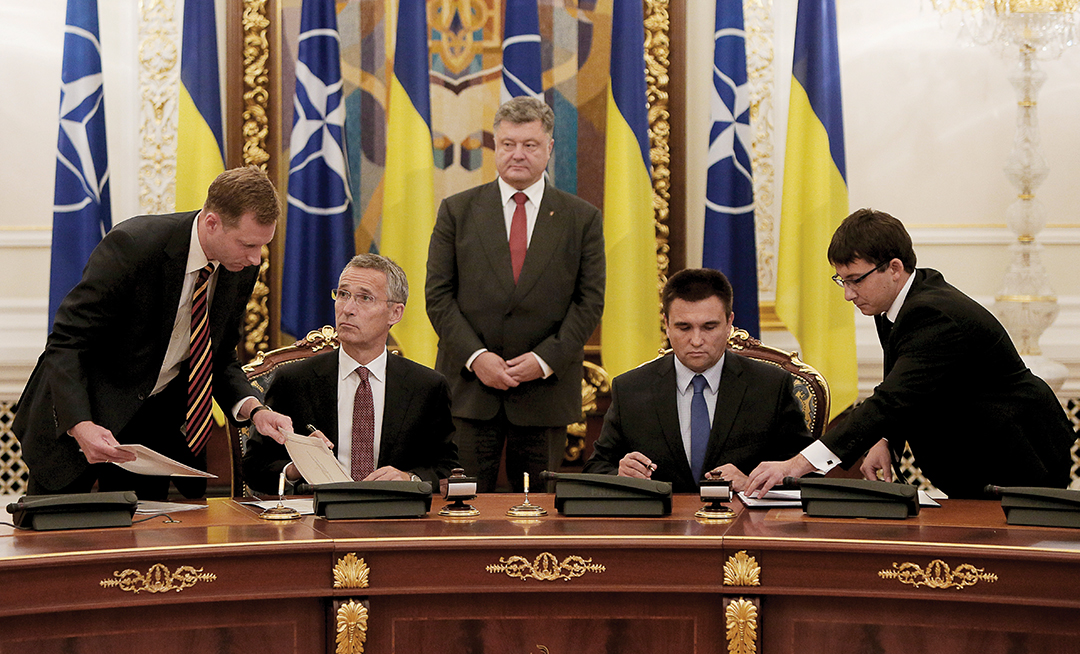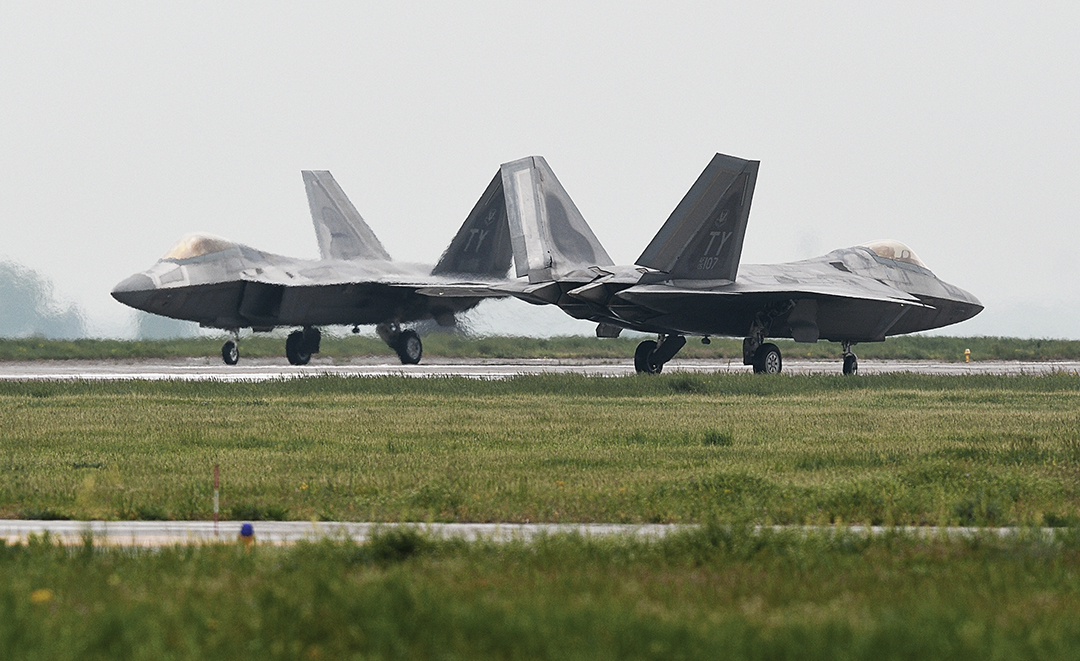International relations theory requires NATO to reassess its strategy toward Russia
By Capt. Evan Kerrane, U.S. Army
Theories can bring structure to a chaotic world and, although sometimes viewed as impractical, they shed light on the perceived irrationality of actors. International relations theories can help explain Russian actions in the recent crisis in Ukraine. While the narrative of Vladimir Putin as a power hungry authoritarian seeking to deny the democratic will of the Ukrainian people appeals to the sensibilities of the West, it is not necessarily the truth and will by no means return stability to Ukraine. NATO and Western powers have pursued a policy based on liberal theories of a democratic peace while denying their approach is anti-Russian. Moscow views this policy differently, as Western influences continue to creep closer to vital geostrategic locations such as Ukraine. It is time for NATO and the West to return to realist theories of power balancing and realpolitik approaches to maintain stability in Europe.

According to Stanley Sloan in his book, Permanent Alliance? NATO and the Transatlantic Bargain from Truman to Obama, as an international institution, NATO benefits from keeping its specific military strategy vague. The NATO charter does not list common enemies or objectives and, for this reason, the Alliance lacks strategic focus and instead agreed to the United States’ policy objectives of democratic expansion into the former Soviet and communist European states, leading many policymakers and academics to believe a unified, liberal democratic Europe was possible. Stemming from liberal theories that argue war is an abnormality in the world and the aggressive instincts of the authoritarian regimes are the root cause of international conflicts, as Michael Doyle writes in his book, Ways of War and Peace, NATO’s new objective became not simply collective security, but the promotion of a new liberal world order. According to Zoltan Barany in a 2009 Journal of Democracy article, the Alliance is viewed as a means for transitioning states to achieve their true objective — admission into the European Union. Policy — in lieu of strategic objectives — places the future of the Alliance in jeopardy as more states with little commitment or contribution to collective security achieve membership.
To the traditional European powers, Russia is no longer viewed as the authoritarian menace of Europe, but as an ally in the European, and world, liberal redesign. Stockholm International Peace Research Institute data indicates that Moscow has increased its military spending by approximately 78 percent annually since 1994. Although Russian spending is dwarfed by that of the U.S., Russia still outspends the rest of Europe. European defense spending continues to decrease with austerity measures: France decreased it from 3.3 percent of gross domestic product between 1990 and 1994 to 1.9 percent in 2013, the United Kingdom from 3.6 to 2.4 percent, and Germany from 2.1 to 1.3 percent during the same period, according to NATO, signaling a corresponding decrease in perceived national security threats. On the other hand, Estonia and the other Baltic states — sharing common borders with Russia — still view Moscow as the primary national security threat. Estonia has increased defense spending from 1.6 percent when it joined the Alliance to 2 percent in 2013. While the shadow of Moscow no longer stretches to Berlin, it still looms over Baku, Kyiv, Minsk, Riga, Tallinn and Tbilisi.
NATO’s 1995 Study on NATO Enlargement touted the importance of Russia as a partner in the stability and security of Europe. However, this optimistic and noble viewpoint by Western Europe and the U.S. set the conditions for today’s instability in Eastern Europe. In February 2015, NATO Secretary-General Jens Stoltenberg encouraged a sovereign Ukraine to continue to choose its own path toward democracy. “Because if they are more stable, we are more secure,” he said. However, Stoltenberg fails to recognize that this push for Ukraine to move under the liberal West’s umbrella is a fundamental cause of Russian interference in Ukraine and, in turn, promotes instability in the eastern portion of the country.
Liberal theory, and more specifically Adam Smith’s liberal pacifism, is based on the belief that the natural state of the world is peace; war is the abnormality. Essentially, under liberal theory, as Kenneth Waltz criticizes in his book, Man, the State, and War, internal aspects of the state influence its external agendas; since merchants are primarily concerned with profit or gain, so too should be the state, eliminating conquest as a legitimate state objective. Ergo, democracies built on free-market capitalism are peaceful states whose regimes are held in check by the merchant class. Therein lies the liberal theorist’s notion of “good,” or democratic, and “bad,” or authoritarian, states in international relations. When it comes to relations with authoritarian states, Western powers enjoy feelings of superiority, claiming they seek peace and stability while the “bad” states cause chaos within the system.
Belief that democratic regimes do not go to war with each other, and therefore create a peaceful system — dogma in the West — has been used in the formation of the Alliance’s enlargement policy. According to Barany, promoting democracy through a state’s political identity became a more important criterion for enlargement than the strategic objectives of collective security, as many states seeking NATO membership face no military-security threats. This is not to dismiss NATO enlargement policy in its totality. In fact, following the Cold War, the strategy served its purpose of bringing important allies into the Alliance while the Russian state was too fragile to resist.

Liberal rhetoric played a key role in promoting the strategy, but the policy hedged NATO concerns about a future Russian resurgence, according to Sloan, as the accession of the Baltic States, strategically important to Russia since the days of Czar Peter the Great, placed them clearly under Western allegiances. Questions of credibility grow, however, as reactions by NATO powers have not corresponded to a rising Russian threat in the Baltics and Eastern Europe. NATO’s disjointed expansion policy succeeded against a weak and internally focused Russia; however, recent events in Ukraine show enlargement has led to instability in Eastern Europe, as the Alliance looks to assert its influence over yet another state that is strategically important to a more powerful and assertive Moscow that has been emboldened by NATO inaction in Georgia and the Baltics.
Waltz points out that, unlike liberal theories, realism offers the alternative view that powers are influenced by external factors and fundamentally seek only survival. At the 2008 Bucharest Summit, NATO foreign ministers agreed to support the membership aspirations of both Ukraine and Georgia, maintaining that NATO’s expansion policy is not strategically aimed at Russian containment but toward promoting peace and democratic reform. Intentions aside, this Alliance objective did not go unnoticed in Moscow: President Vladimir Putin is reported to have warned U.S. President George W. Bush that if Ukraine achieved membership status it will “cease to exist.” Putin’s threat, which by no means appears idle, surfaces from a vital Russian national security concern regarding Ukraine, as well as a growing sense of Russian nationalism.
Throughout Russian history, the geographic distance between Moscow and the “Great European Powers” was always one of its greatest strengths; the farther European invaders marched into Russia, the more difficult their campaigns became. The flat, expansive Ukraine served as the launching point for three great invasions of Russia; by Napoleonic France, imperial Germany and Nazi Germany. Today, NATO is much closer, physically and in capability, to Moscow and its strategically important southern flank. Liberal theory argues that Russian actions in Ukraine are the actions of an authoritarian state, but this perception fails to recognize that Russia is protecting its vital security interests by denying to a perceived enemy strategically important territory within its sphere of influence. Although NATO leaders continue to emphasize that Ukraine is destined to achieve membership in the Alliance, Russia’s continued interference in the East shows the political realities of Europe, according to John Mearsheimer, along with the naiveté of Western leaders who believed the Russians would allow such a strategically important border state to become a Western satellite.
A strategy of clandestine operations in Eastern Europe remains the only strategic option for the Russians, because any direct confrontation with the West will end in defeat. Additionally, this strategy causes internal instability in Ukraine and Georgia, diminishing their suitability as NATO member states. Moscow views Ukraine as a battle for Russian survival. This requires a corresponding realist strategy from the West. More importantly, if the Alliance seeks to maintain credibility in Eastern Europe and the Baltics, the European powers must show more than indifference to Russian aggression. NATO must regain its status as the premier organization of collective European security for all members and refrain from merely being the stepping stone for transitioning European states seeking EU membership.


Comments are closed.